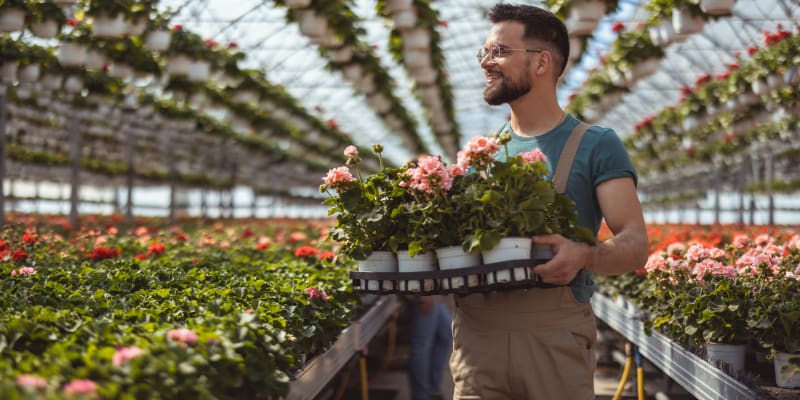Safe lifting and moving materials in greenhouses: 5 ways to prevent injuries

Ontario’s greenhouse sector is booming. Strong growth and increased production are positive signs for the industry. However, the increased production has also been accompanied by an increase in occupational injuries. “Without a doubt, the greenhouse sector has seen significant growth in recent years, but it also has the highest rate of lost-time injuries in the agriculture sector,” says Kristin Hoffman, Health and Safety Consultant with Workplace Safety & Prevention Services.
Some of the main risks greenhouse workers face involve handling and transporting materials. Between workers, equipment, supplies, and crops, something is always moving in a greenhouse operation. And when you have workers near moving equipment—whether it’s a cart of just-picked tomatoes or a forklift moving an empty pallet—there’s a risk of workers being hit.
“When we talk about transporting material, we’re talking about everything from how workers push carts and lift boxes, how they use forklifts to move crates, and how they stack bags of fertilizer for storage,” explains Kristin. “Essentially, we’re looking at the movement of equipment and material to ensure that it is done safely.”
When the Ministry of Labour, Immigration, Training and Skills Development (MLITSD) focused their attention on safe material handling in Ontario’s agriculture sector last year, they focused on three things: how agriculture workers move things manually, how they use equipment to move things, and how things are stored.
Manual versus mechanical handling
Every day, greenhouse workers manually push, pull, lift, and carry things of all shapes and sizes to keep the operation running. Over time, they often suffer from injuries to their muscles, joints, tendons, and ligaments (e.g., back or shoulder injuries). Collectively, these types of injuries are called musculoskeletal disorders (MSDs). If not addressed, they can lead to long-term pain and reduced mobility that can significantly impact their quality of life.
Equipment such as forklifts and conveyors can reduce the risk of injuries to muscles and joints by eliminating the manual lifting, pushing, pulling, etc. “Using mechanical equipment to move material is a great way to eliminate the strain on your body and reduce the risk of developing an MSD, but it can also lead to critical injuries or fatalities if the proper training and procedures are not in place,” warns Kristin. There’s no doubt that they help to increase productivity, reduce the risk of injury from repetitive movements, and make it easier to get work done. However, they also introduce new hazards to the workplace. If a worker gets caught in a conveyor’s pinch point or is hit by a forklift, it will likely result in a critical injury or fatality. “The hazards associated with mechanical equipment often led to more severe injuries,” says Kristin. “However, effective training, planning, and documented procedures can mitigate the risk.”
Get started with these 5 tips
Farm owners and operators are required by law to inform workers of the hazards they will face on the job. They are also required to take every reasonable precaution to protect their workers. Kristin offers this advice to help you protect yourself and your workers from serious injury.
- Start with a hazard assessment. Go through each task and think about the hazards associated with each step. Then, identify what you will do to minimize the risk. For example, if you are working with a conveyor, locate the pinch points and ensure guards are in place. Use this information to create a safe work procedure.
- Provide training. Everyone who works with mechanical equipment (e.g., forklift or pallet wrapper) must be trained on how to safely operate it. They also need to understand the hazards associated with it. Once you have established a safe work procedure, train your workers. Then, observe them using the equipment to ensure they understand how to do it safely. “Even those who may not operate a forklift or lift truck should have a clear understanding of the hazards and know where the operator’s blind spots are,” says Kristin.
- Always use machine guards. Doing so will help to prevent workers from getting caught in pinch points, which can lead to serious injuries. Training should include which guards are for which equipment, how to use them, and how to recognize when they are not properly installed.
- Do not overload equipment. When filling bins or carts, keep the weight manageable to avoid strain when pushing or pulling. When using racking or other storage systems, make sure to follow capacity guidelines to avoid collapsing racks.
- Stretch, rotate jobs and adjust the work area. Teach greenhouse workers how to prevent muscle and joint injuries by stretching regularly and lifting properly. Break up repetitive jobs by rotating tasks to avoid straining a specific part of the body (e.g., back, knees). Design the work area to minimize bending, reaching, crouching, etc.
How WSPS can help
Consulting
WSPS’s agriculture health and safety experts can help you improve your health and safety program, address material handling hazards, and prevent injuries in your workplace.
Training
- JHSC Certification Training – Part 2 Agriculture (online instructor-led, 2 days)
- Safety, Health, and the Law for Greenhouses (online, instructor-led, 1 day)
- Health & Safety Awareness Sessions (instructor-led, 1-2 hours)
- Tractor Safety Training (eCourse, 1 hr)
- Manual Material Handling Training (eCourse, 1 hr)
- Inspecting and Maintaining Steel Storage Racks Training (online instructor-led, 1 day)
Webinar
- Managing Agriculture Safety Without a Safety Department (Free Safety Connection webinar)
Resources
- Greenhouse Health and Safety
- Greenhouse Safety Resources in Multiple Languages
- Material Handling Resources in Multiple Languages
- Machine Safeguarding Poster
- Health and Safety Orientation Handbook Generator
- Farm Safety Roundup (podcast)
- Prevent Struck-by Injuries in the Greenhouses
The information in this article is accurate as of its publication date.




